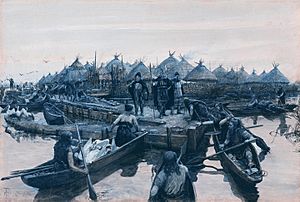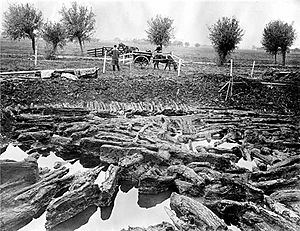Glastonbury Lake Village facts for kids
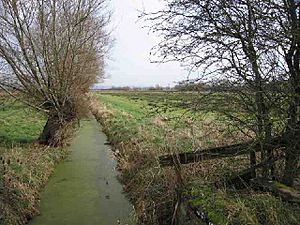
Site of Glastonbury Lake Village
|
|
| Location | Near Glastonbury |
|---|---|
| Region | Somerset, England |
| Coordinates | 51°09′49″N 02°43′33″W / 51.16361°N 2.72583°W |
| Type | Village site |
| History | |
| Periods | Iron Age |
| Site notes | |
| Condition | Ruin |
Glastonbury Lake Village was an amazing ancient village. It was built during the Iron Age, a time long ago when people used iron tools. This village was special because it sat on a crannog, which is a man-made island. You can find its remains in the Somerset Levels in southwestern England, near Glastonbury. Today, it's a protected historical site called a scheduled monument.
Many experts say it's "the best preserved prehistoric village ever found in the United Kingdom." The village was quite large, about 400 feet (120 meters) from north to south and 300 feet (90 meters) from east to west. People started building it around 250 B.C. They created a strong base using timber and clay. On this base, they built wooden houses and barns. Up to 200 people lived here at any one time. The village was used until about 50 B.C., when it was abandoned.
A local student named Arthur Bulleid discovered the site in 1892. He and others spent the next 15 years digging it up. They found many cool things like wooden and metal objects. You can see many of these finds today. Some are at The Tribunal in Glastonbury, and others are in the Museum of Somerset in Taunton. Much of the wood from the village was reburied. This was done to keep it safe and preserved. Later studies show this method worked well. However, the site is still at risk if the soil dries out too much.
Contents
Life in the Iron Age Village
The Glastonbury Lake Village was first built around 250 B.C. People lived there until about 50 B.C. Then, they left, possibly because the water levels rose too high. The village was built on marshy ground. Its base was an artificial platform made of timber, brushwood, and clay. Workers brought over 1,000 tons of clay from about 1 kilometer away!
The village had five to seven groups of round houses. Each group was likely home to a large family. There were also sheds and barns for animals and storage. These buildings were made from hazel and willow branches. They were covered with reeds. A wooden fence, called a palisade, surrounded the village. Experts think this fence helped make the clay floors stable, rather than being just for defense. At its busiest, the village might have had 15 houses in use. Around 200 people could have lived there.
Early houses in the village were square or rectangular. They were made of oak wood. Later, people built circular huts. Some clay areas were used for barns or animal pens, not just houses.
Village Location and Trade
The village was near the old path of the River Brue. People once thought it was completely surrounded by water, like a "Lake Village." But now, experts believe "Swamp Village" might be a better name. This is because for most of the year, the land around it was not open water. The River Brue was an important route for trade. It connected central Somerset to the Severn Estuary.
Villagers reached the site using causeways, which were like raised paths, up to 130 feet (40 meters) long. Log boats have been found near the village. These boats suggest there was a landing stage, a place where boats could dock. This landing stage was repaired many times. Even though the area was wet, the villagers ate mostly vegetables and small animals. These included beavers and otters, not just fish. They also grew crops like wheat, barley, and beans.
Discovering the Ancient Village
The Glastonbury Lake Village, a man-made island, was found in 1892. It was discovered by Arthur Bulleid, a local medical student. His father was a mayor and started the Glastonbury Antiquarian Society. Arthur had heard about similar lake villages in Switzerland. He thought there might be some in Somerset too.
The digging, or excavation, started in 1892. It continued for 15 years. The team uncovered how big the settlement was. They also published their findings. From 1892 to 1899, Bulleid worked with laborers for six months each year. The other six months were spent describing and listing all the finds. He then paused to finish his medical studies. In 1904, he returned with Harold St George Gray. They continued the excavation until 1907. Gray was trained in archaeology and was the curator of the Taunton museum.
They found the remains of the village. It had 89 mounds, from 1.2 meters to 4.3 meters wide. These mounds were made of clay laid over the marshy ground. Many had central fireplaces. A wooden fence made of Alder trees surrounded the whole site. Every find, from large pieces of wood to tiny pottery bits, was drawn and described. Some were even photographed. In 1909, George V visited the site. He was the Prince of Wales at the time. He and his wife were given a silver copy of the Glastonbury Bowl.
Much of the wood was reburied. This was the best way to keep it preserved. A survey in 2005 showed this worked well. But there are still worries about the area drying out. The site is on the Heritage at Risk Register. This means the buried wood is in danger if the site gets too dry. Bulleid and Gray later dug up a similar site. It was called Meare Lake Village, about 2 kilometers from Glastonbury.
Smaller digs have happened since then. A film has even been made about the most recent excavations. The village landscape has been made into a 3D model. You can see it in a short film. A copy of a canoe found at the site has also been made and launched.
Amazing Artefacts Found
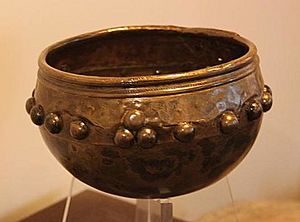
The Glastonbury Antiquarian Society owns the site and all the items found there. Many of these finds are on display. You can see them at the Glastonbury Lake Village Museum. This museum is located at The Tribunal in Glastonbury High Street. More items are at the Museum of Somerset in Taunton. Diggers found the burial sites of ten newborn babies. However, there was no sign of adult burials from the village.
The objects found include pieces of pottery, charcoal, bone, and whetstones. Whetstones are stones used for sharpening blades. Later, they found spinning whorls and weaving combs. These tools suggest people were making textiles, like cloth. This was probably for their own use, not for selling. Evidence of bronze-casting and iron-smelting was also found. This means they worked with metals. Beautiful jewellery made from bronze and bone was also discovered. This shows they were very skilled craftspeople.
The Famous Bronze Bowl
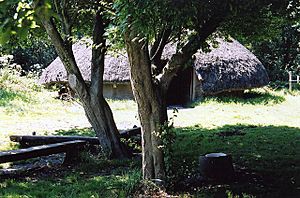
One special find is the metal "Glastonbury Bowl." It was made from two parts joined together with rivets. It was also repaired several times during its life. The bottom part was made in the Iron Age. The top part was likely added in the 1st century. It was made from one piece of metal. This metal might have been used for something else before. Then, the two halves were riveted together.
Wooden Treasures
The wet, peaty soil helped preserve many wooden objects. These include five wheel spokes. There was also an unfinished nave, which is the center part of a wheel. Woven baskets were found. Some were as wide as 700 mm (27 inches) and as tall as 480 mm (19 inches). A wooden frame for stretching animal skins was also recovered. They even found a shaker and dice made from antlers!
Replicas of the village houses were built at the nearby Peat Moors Centre. This center was run by Somerset County Council. It closed in 2009.


